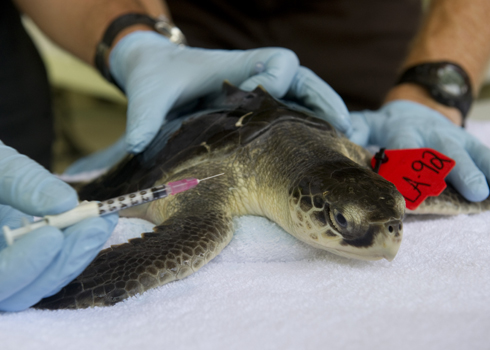We told you yesterday about a 2007 document that shows that the National Marine Fisheries Service drastically underestimated the size of a potential oil spill and its effect on endangered species like sea turtles when they signed off on lease sales for drilling sites in the Gulf. A Fisheries official now tells TPMmuckraker that, once the leak is resolved the agency will revisit the opinion.
The agency is charged with enforcing the Endangered Species Act, and part of its mandate is to consult with other federal agencies on whether a proposal — in this case, opening more of the Gulf to oil and gas drilling — will jeopardize the existence of protected species.
In 2007, the Minerals Management Service consulted with Fisheries on new proposed lease sales in the Gulf. Fisheries signed off, saying the new drilling wouldn’t jeopardize the populations of certain sea turtles, sperm wales and sturgeon.
Part of the reason they signed off was because they relied on MMS’s assurances that a leak this big was highly unlikely. Instead, they measured a “major spill” as half the size of the 1979 Ixtoc disaster. The BP spill has already, by conservative estimates, passed that half-mark — and, by the biggest estimates, has surpassed Ixtoc in its entirety.
Jim Lecky, who heads Fisheries’ office of protected resources, stood by those estimates in an interview with TPMmuckraker today.
Lecky pointed out that Fisheries doesn’t have expertise on oil drilling, so they had no choice but to rely on MMS, which regulated the industry. And, as Lecky said, there was “no expectation” of a spill as big as the current one.
“There had been a lot of advancements at the time,” he said. Deepwater drilling technology “is technology that’s been around for a while … it’s proven technology, and we still don’t know what happened now.”
He also took issue with our framing of yesterday’s story, saying his agency didn’t underestimate the number of turtles killed by a major oil spill like BP’s. They never analyzed a spill this big, or its effects because it was deemed just too unlikely.
“Spills of this magnitude are really rare events, like airplane crashes are really rare. But people still keep getting on planes every day,” he said. If they stopped a project because of any small chance of disaster, he said, “then we really wouldn’t do much.”
The Fisheries service is now, amid the chaos of the ongoing disaster, trying to work with other agencies to minimize the effects of the spill response effort on turtles and other species. After the spill is over, Lecky said, the agency will analyze the effects of the spill on wildlife, and revisit both the 2007 opinion and other Gulf-related opinions they’ve issued.
The 2007 opinion is still in use, as it applies to lease sales through 2012.
The 2007 opinion estimated that some 60 turtles of endangered species — Kemp’s ridley, leatherback, hawksbill, loggerhead and green — would be killed by oil spills over the 40 year lifetimes of the leases.
Since the current spill, 438 turtles have been found dead. Of the 601 turtles found in the spill area, either dead, stranded, or healthy, 79% have been Kemp’s Ridley turtles. Loggerhead, green and hawksbill turtles have also been found in the spill area.









